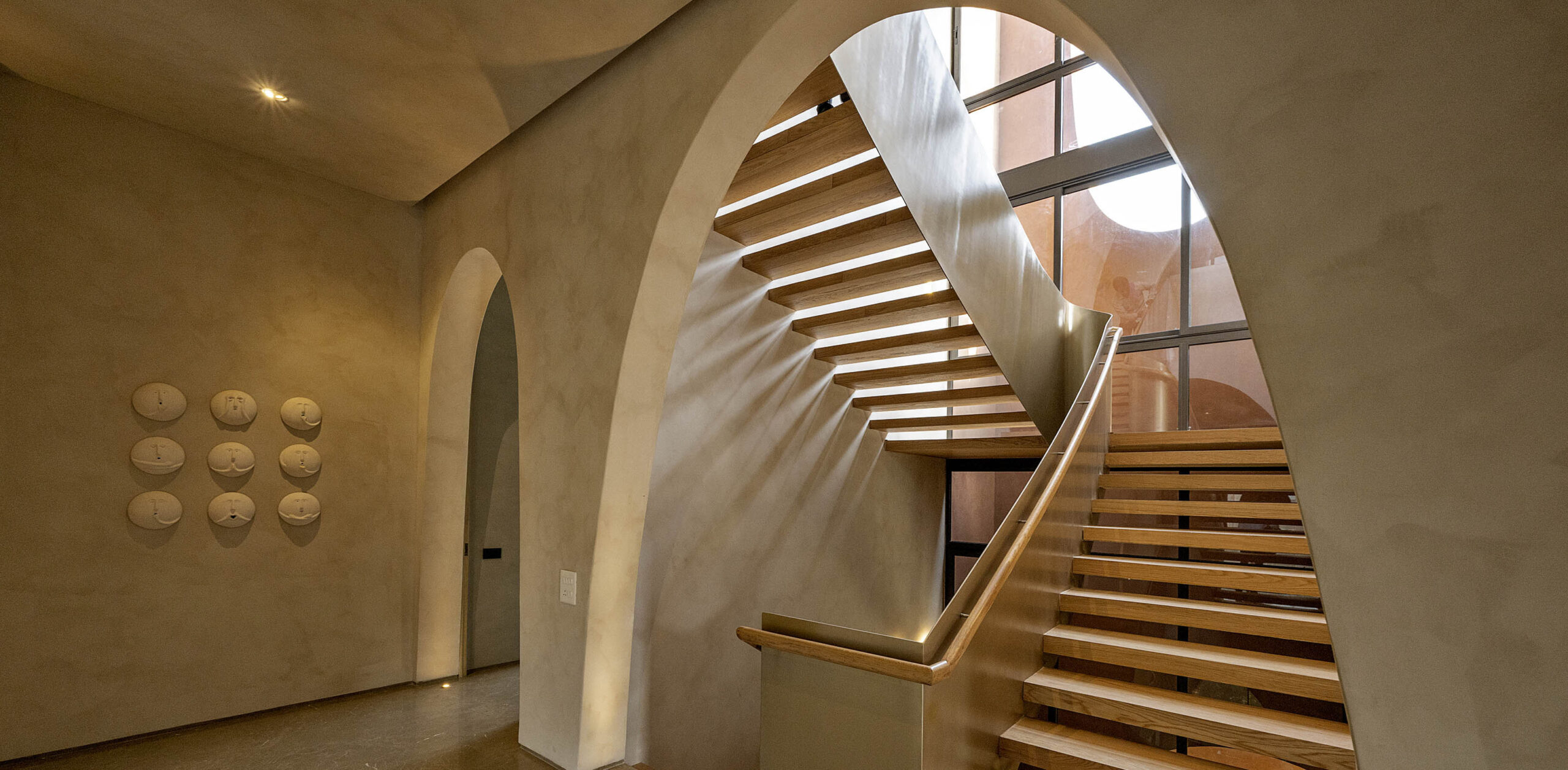Ema is a trained architect, writer and photographer who works as a designer at REX in NYC. Inspired by her global experiences, she shares captivating insights into the world’s most extraordinary cities and buildings and provides travel tips on her personal blog, The Travel Album.
In the ethereal dance of celestial wonder, the Northern Lights, or Aurora Borealis, reign supreme as one of nature’s most captivating spectacles. Chasing the Northern Lights usually means booking a trip somewhere pretty far, to destinations like Norway, Iceland or even the northernmost provinces of Canada. However, this year, something has caught my attention. I’ve come across numerous articles online with titles such as “2024: The Ultimate Year for Northern Lights Viewing.” There have been widespread reports of the auroras being exceptionally vibrant in 2024 compared to the past decade. This sparked my curiosity about what might be causing such a significant increase in aurora activity.
The colorful ribbons you see in the sky are caused by activity on the Sun’s surface and the interaction of solar wind particles with Earth’s atmosphere. Solar storms release charged particles that can travel millions of miles and sometimes collide with Earth. These particles interact with our atmosphere, heating up atoms and molecules and making them glow. This creates the aurora, with its distinctive patterns and curtains of light, influenced by Earth’s magnetic field lines. Different gas molecules in the atmosphere create varying colors, with oxygen producing green and red hues, while nitrogen results in a blue and purple glow.
As the sun approaches its peak of solar activity in an 11-year cycle, the northern lights are stronger this year, especially around the March and October equinoxes. This article caters to avid aurora chasers and those seeking inspiration for an unforgettable Nordic experience. 2024 stands out as an exceptional year to witness this phenomenon, and there are several architectural marvels across Iceland, Norway, and Sweden that provide perfect spots for witnessing this breathtaking display of lights.
Cathedral of the Northern Light
By LINK Arkitektur, Schmidt Hammer Lassen Architects

Cathedral of the Northern Light by LINK Arkitektur, Schmidt Hammer Lassen Architects
Rising majestically in Alta, Norway, the Cathedral of the Northern Light is not just a religious and architectural landmark but it’s also meant to be a public space where locals and visitors can observe the inspiring spectacle of the northern lights. The building was sculpted with intention, spiraling upwards as if reaching towards the sky.
In their quest to capture the essence of the northern lights, the architects described the building as “ethereal, transient, poetic, and beautiful,” mirroring the captivating qualities of the aurora borealis itself. The spiraled titanium cladding captures the daylight in a unique manner, and throughout the extended, dark winter months, it reflects the vibrant hues of the northern lights, enhancing the experience and adding to its spectacular nature.
Aurora Lodge
By Snorre Stinessen Architecture
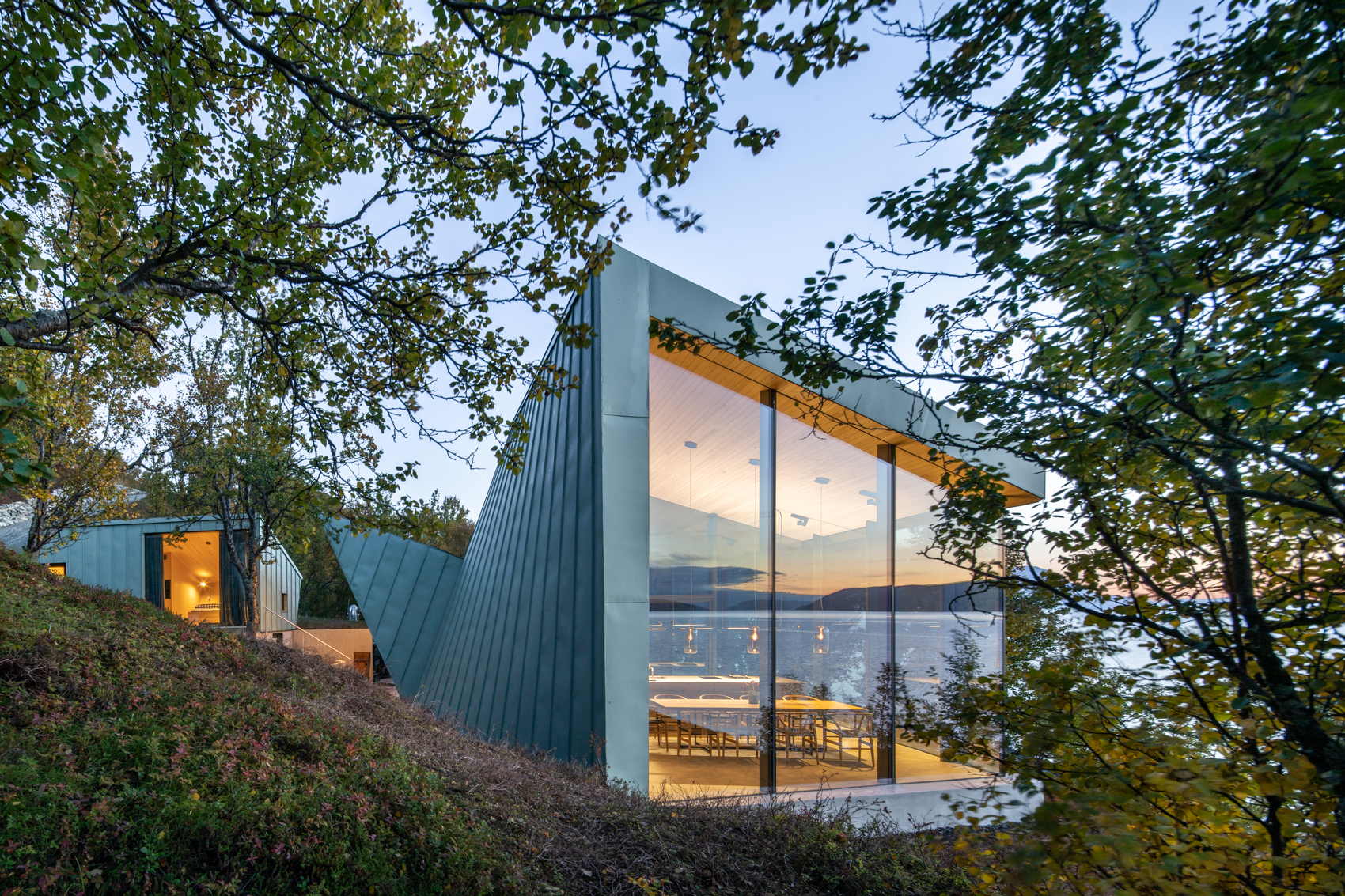
Aurora Lodge by Snorre Stinessen Architecture
All of the aurora buildings in this article share a common trait: their remote locations and close connection to nature. The Aurora Lodge is no different, situated on the seashore of the Lyngen peninsula. The private chalet’s large glass windows framing the waterfront provide incredible views, while the high ceilings and tall glass walls ensure an uninterrupted panorama of the surrounding landscape, fostering a strong bond between occupants and the outdoors. The residence is clad in Nordic Green Copper, a resilient material well-suited for construction in coastal areas with high air salinity. Similar to the ever-changing patterns in the sky, over time, the copper could develop a patina in shades of blue, green, and turquoise, echoing the colors commonly witnessed in the sky during the northern lights.
The 7th Room
By Snøhetta
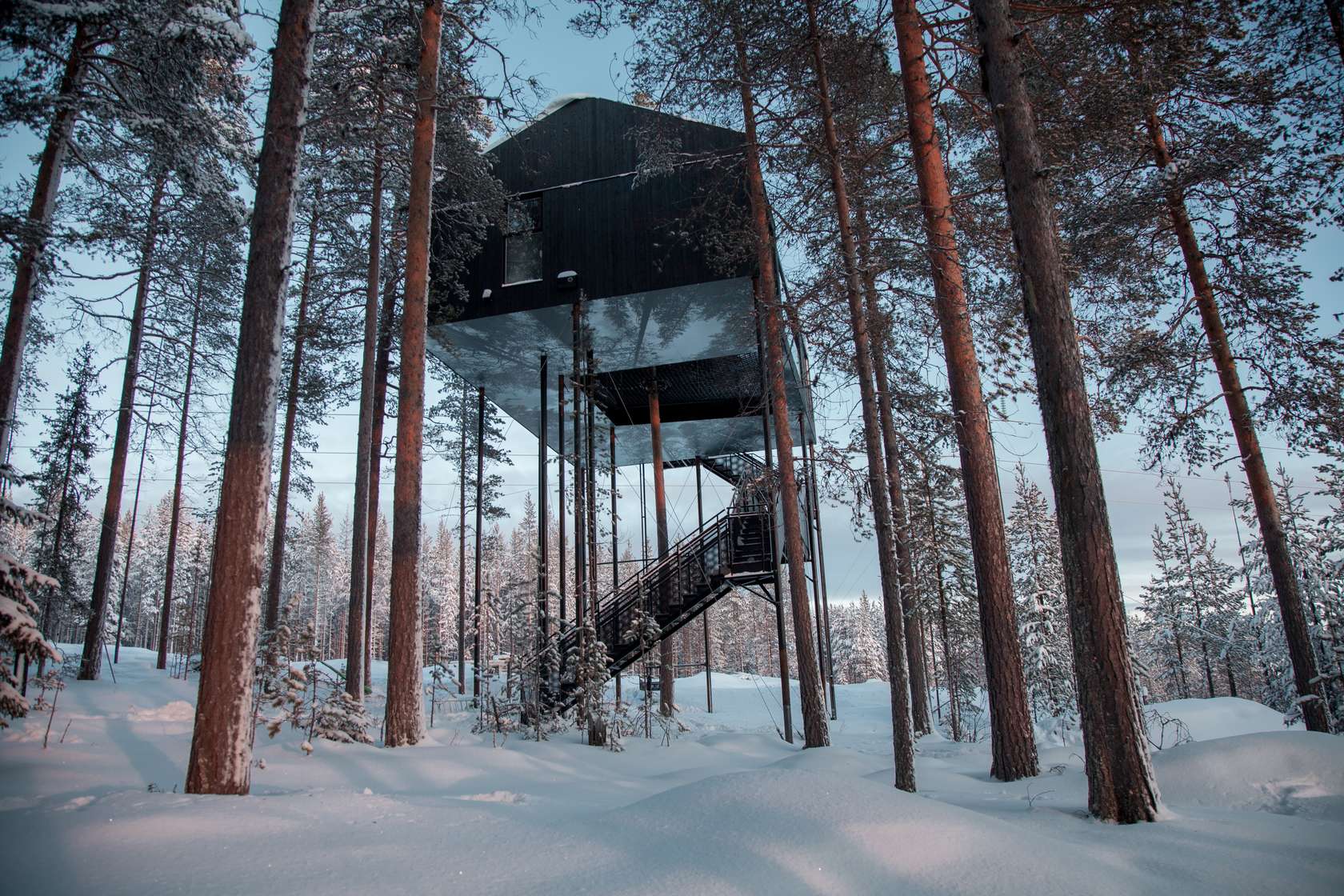
The 7th Room by Snøhetta
Unlike the Tree Hotel, which is perched atop a tree trunk, the 7th Room in Norrbottens län, Sweden, is elevated among the treetops, supported by twelve tall, slender stilts. Once again, visitors are placed within nature itself. The interior features Scandinavian-style furniture, blending natural materials like wood and leather with sleek lines for a warm, tranquil, and modern ambiance. There are windows on all sides of the building, and on clear nights, the aurora borealis is visible through the large north-facing windows of the cabin. Guests can also enjoy views of the night sky and the northern lights from their bedrooms through expansive skylights built into the ceiling. A standout feature of the house is a pine tree that extends through its center, physically bringing a piece of nature indoors, exploring the threshold between indoors and outdoors, and enveloping residents in an immersive, nature-infused living environment.
Efjord Cabin
By Snorre Stinessen Architecture
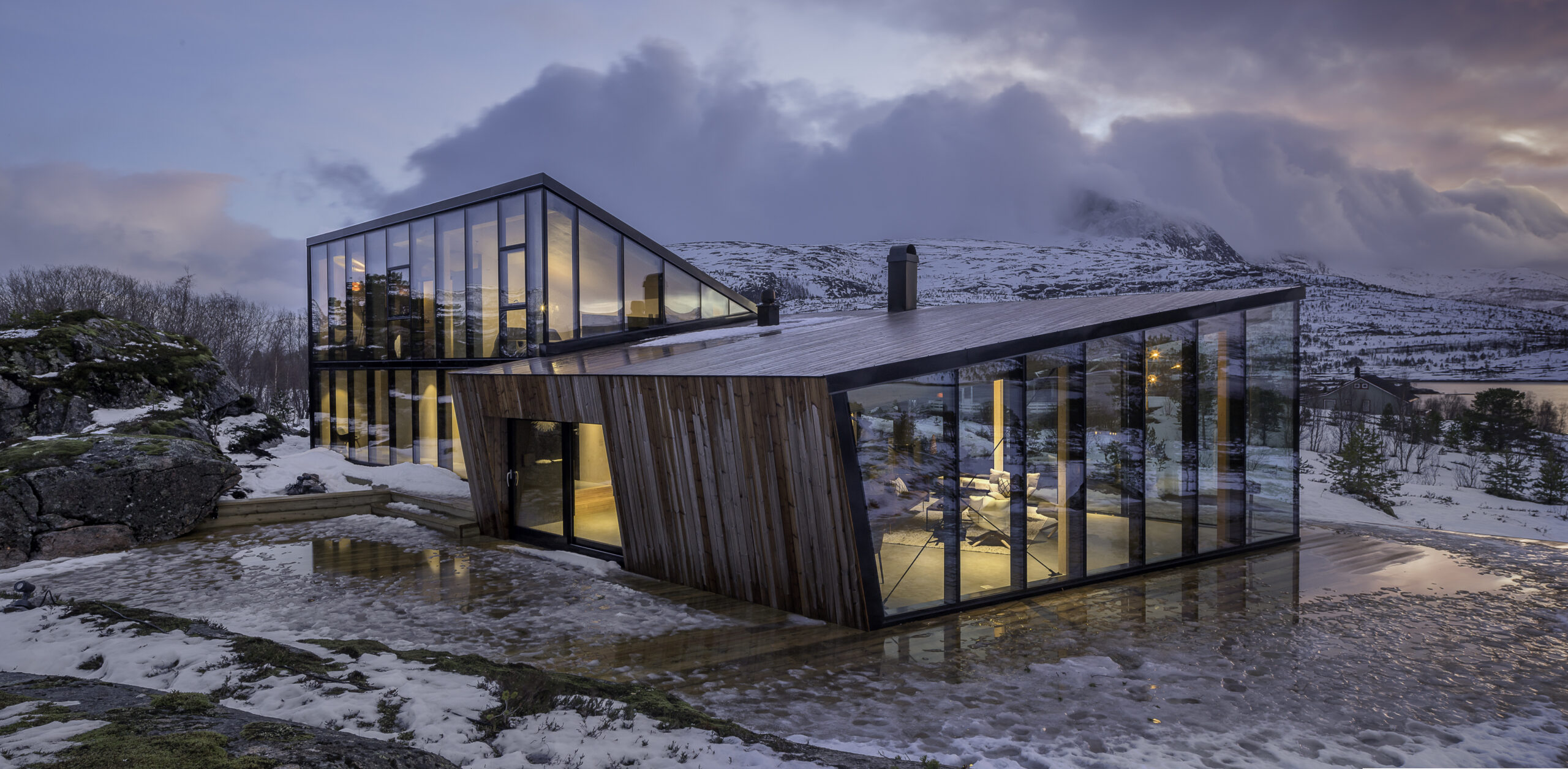
Efjord Cabin by Snorre Stinessen Architecture
Just as spectacular as the aurora borealis itself, imagine the breathtaking panorama of the Norwegian mountains and fjords unfolding before your eyes from the comfort of your living room. The design of the home is meant to guide you from the entrance corridor to the living room, where floor-to-ceiling windows frame this breathtaking view. It’s strategically positioned to maximize sunlight, views, and privacy, particularly during winter when there are ample opportunities to witness the northern lights. Split into two halves to harmonize with the subtle landscape variations, the home is designed with its own two peaks oriented in opposite directions, creating a visual dialogue with the surrounding mountain peaks. Crafted from locally sourced materials such as pinewood and birch, both inside and out, the home forms a profound connection with the local environment.
Ion Luxury Adventure Hotel
By minarc
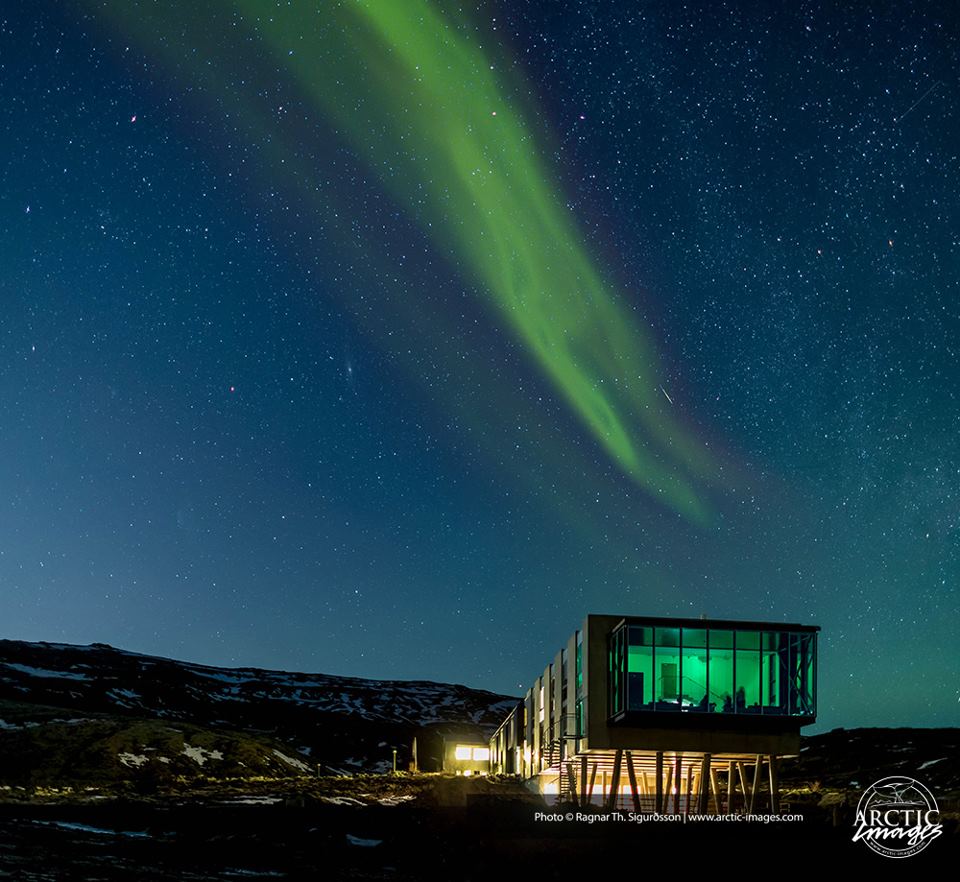
Ion Luxury Adventure Hotel by minarc
Nestled in the breathtaking scenery of Iceland, the Ion Luxury Adventure Hotel has a unique architectural design: half of the structure is elevated on stilts, while the other half is built into the Mt. Hengill landscapes. Set against the rugged Icelandic terrain, and away from any city lights, this modern design is located just west of Thingvellir National Park, standing as a secluded and isolated retreat. Surrounded by natural hot springs, the hotel provides a serene sanctuary, perfect for Aurora Borealis enthusiasts and travelers looking to connect with the natural world. The exterior, constructed with a panelized system and prefabricated materials, maximizes natural light and offers outdoor living spaces, providing guests with panoramic views and a profound connection to nature. Each room has large windows offering views of the surrounding lake and mountains, where the northern lights provide a spectacular light show during the winter months.
Manshausen Island Sea Cabins
By Snorre Stinessen Architecture, Steve King Architectural Imaging
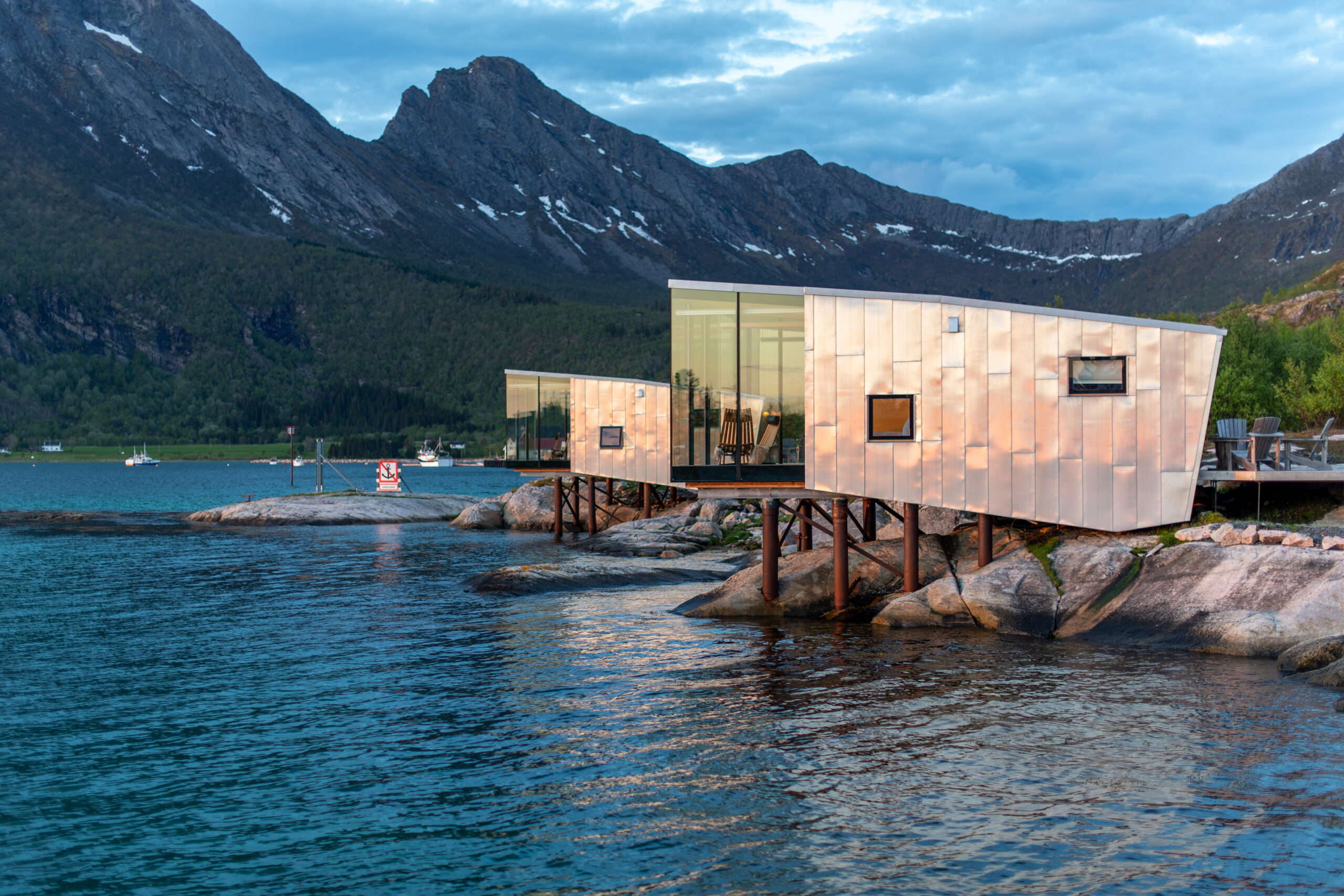
Manshausen Island Sea Cabins by Snorre Stinessen Architecture, Steve King Architectural Imaging
Nestled at the northernmost tip of Norway rests the Steigen Archipelago, a cluster of small islands, including Manschausen Island. Located approximately 100 km above the Arctic Circle, Manschausen Island is nestled amidst a landscape of mountains and sea, where a rich diversity of unique skies, weather patterns, and seasons unfold. Nestled amidst diverse topography, the resort’s cabins vary in elevation, with some partially cantilevered over the sea and nestled into rocky formations, while all are strategically positioned to maximize outward views and preserve privacy. Each cabin has a fully glazed front, acting as the structure’s focal point, while the back is clad in either metal or wood. Don’t be afraid to embrace the idea of staying here, amidst this remote northern landscape, for these cabins offer an abundance of opportunities to immerse yourself in local activities. By day, guests are encouraged to engage in fishing, kayaking, and hiking around the island and its neighboring isles, while every night brings a unique display of the northern lights.
Tree Hotel
By Tham & Videgård Arkitekter
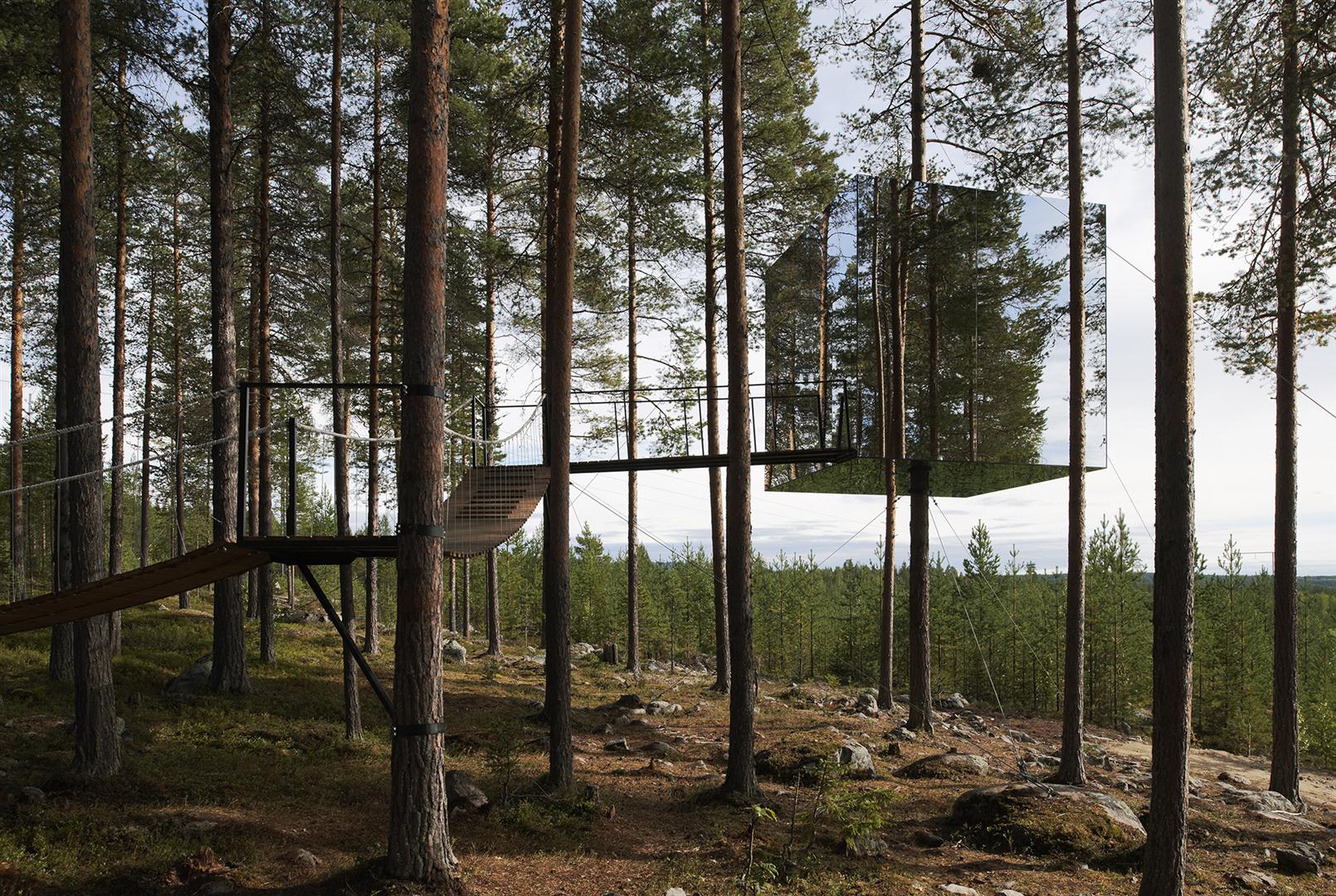
Tree Hotel by Tham & Videgård Arkitekter
Nestled amidst the lush forests of Harads, Sweden, the Tree Hotel offers a unique perspective on the northern lights. Should you ever have the opportunity to stay here, you’ll ascend along an elevated pathway through the trees to your entrance perched among the treetops. The Tree Hotel beautifully showcases the symbiotic relationship between humanity and nature by providing guests with an immersive experience amidst the natural surroundings.
The exterior is made entirely of reflective glass and rests atop a relatively slender pine trunk, creating an illusion of weightlessness while camouflaging into its environment. The hotel’s square windows, visible only at night, complement the cube’s overall design aesthetic and provide a view from all four sides, inviting guests to observe the vibrant hues of the illuminated night skies from inside.
While the auroras are typically visible in regions close to the Arctic Circle, such as Norway, Sweden, Iceland, Finland, and Alaska, they can occasionally be seen at lower latitudes during periods of heightened solar activity. The best time to see the northern lights is during the winter months, from September to March, when nights are long and skies are dark. Additionally, clear, cloudless nights increase the likelihood of witnessing this natural phenomenon. Planning a trip to these northern regions during the winter months, away from light pollution, offers the best chance of experiencing the magnificent display of the northern lights dancing across the sky.
Would this be something you’d consider planning your trip around?
Architects: Want to have your project featured? Showcase your work through Architizer and sign up for our inspirational newsletters.
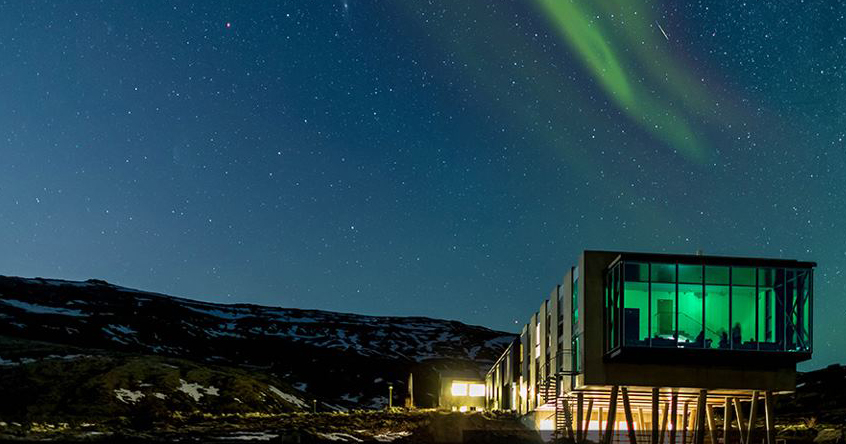





 Cathedral of the Northern Light
Cathedral of the Northern Light  Efjord Cabin
Efjord Cabin  Ion Luxury Adventure Hotel - ICELAND
Ion Luxury Adventure Hotel - ICELAND  Manshausen Island Sea Cabins | Snorre Stinessen
Manshausen Island Sea Cabins | Snorre Stinessen  The 7th room
The 7th room  Tree Hotel
Tree Hotel 
